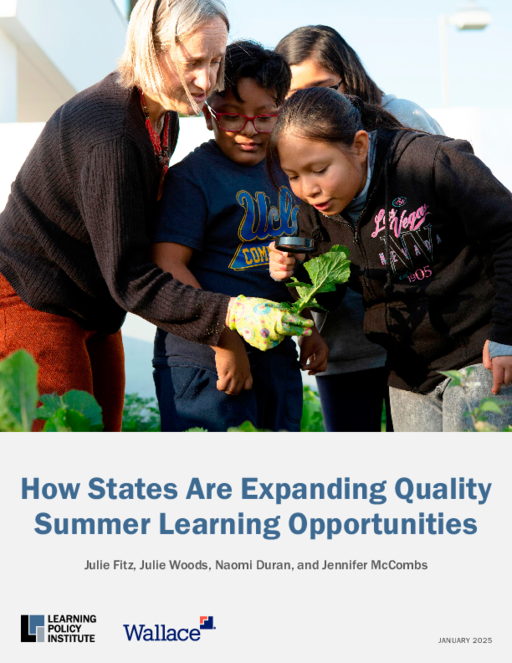- Author(s)
- Julie Fitz, Julie Woods, Naomi Duran, and Jennifer McCombs
- Publisher(s)
- The Learning Policy Institute
- DOI Link
- https://doi.org/10.54300/910.329
Research Approach
This study sought to understand the policies and practices that states have developed to expand access to high-quality summer learning and to share what they have learned about how to effectively support summer learning at the state level.
Using a case study approach, this study draws on interviews with participants from nine states, which were conducted in the fall and spring of the 2023–24 school year. In each state, LPI researchers identified one to seven key individuals to interview, representing a range of agencies, including state education agencies (SEAs), governor’s offices, state after-school networks, and other nonprofits involved in the summer learning space. In total, researchers conducted 30 semi-structured interviews with 28 participants, ranging between 30 and 90 minutes long, and had follow-up conversations with interviewees to ask clarifying questions as needed. Participants were asked about recent, ongoing, or planned summer learning initiatives, many of which built on previous or long-standing initiatives. This resulted in the inclusion of ongoing investments that were initiated as far back as 2014, although interviewees from all states also discussed investments made with federal recovery dollars between 2021 and 2024. Interview protocols were designed to facilitate discussion on topics including:
- the origins of the state’s vision for summer learning;
- state mechanisms for supporting summer programming, including funding, guidance, and legislation;
- state data collection and usage; and
- successes and challenges to standing up and sustaining quality summer programming.
To supplement interviews, researchers gathered and analyzed website content, evaluation reports, and training materials. Each of these sources supported descriptive and thematic analysis.
The research design and analysis were guided by the following research questions:
- How are states supporting high-quality summer learning programs through policy and practice?
- What contextual factors influenced the approach the state is using?
- How did leaders within the state create and generate support for the state role in summer learning?
- How are states collecting and using data about impact?
- How has state action promoted more equitable access to summer learning opportunities?
- What lessons have state officials learned about developing and implementing policies and practices to support high-quality summer programming?
Notably, this study did not assess program quality, although it did attend to the state practices that promoted the adoption of program features that have been associated with quality and positive outcomes in the research literature.
The study also benefited from the input of project advisors from the National Governors Association; National Summer Learning Association; Council of Chief State School Officers; Afterschool Alliance; and National Conference of State Legislatures in case study selection and the development of study protocols, research products, and the dissemination strategy.
This study has limitations that are worth noting. The analysis presented in this report draws on information only from the nine states included in the multiple case study and, as such, does not comprehensively describe the practices and strategies adopted by states across the country. LPI’s intention was not to evaluate program quality or outcomes (although they have shared quality and outcomes data produced at the state level when available), but rather to understand, from the perspective of interviewees, the policies and practices that supported the effective implementation of state-level programs to support summer learning. Additionally, in some states, investments in summer learning started several years ago, whereas others are more recent. For long-standing investments, interviewees’ understanding of early days of the programs were in some cases limited. Furthermore, the small number of interview participants included from each state—and the very different roles and organizations they represented—means that researchers may have gotten a limited perspective on states’ practices, despite their best efforts to corroborate and enrich the narratives participants shared with additional state documentation. The study’s focus on state-level agencies means that researchers did not interview the summer learning providers who have been impacted by state initiatives, which limits understanding of the successes and challenges of state grant programs from this important perspective.

